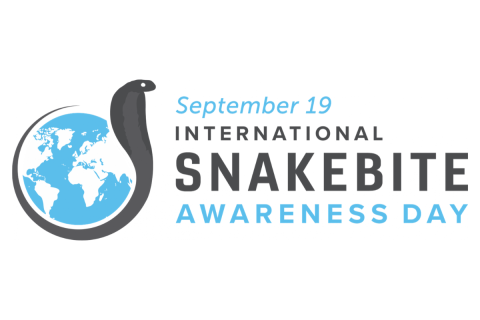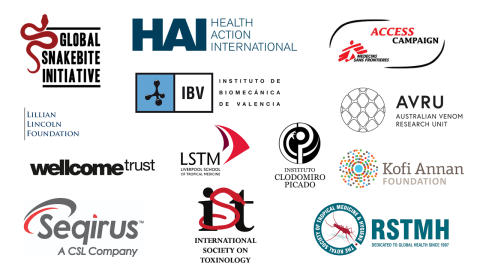The first-ever International Snakebite Awareness Day

Today – 19 September – a coalition of organisations working on global health and tropical medicine around the world, including the Royal Society of Tropical Medicine and Hygiene, is announcing the first-ever International Snakebite Awareness Day.
The launch of International Snakebite Awareness Day aims to raise awareness of the huge, yet mostly unrecognised, global impact of snakebite.
The World Health Organization estimates that between 81,000 and 138,000 people around the world die each year from snakebite and up to 400,000 are left permanently disabled or disfigured, as a result of being bitten by venomous snakes.
In many communities, these permanent injuries result in people being discriminated against and ostracised. It leads to crippling loss of income, debt, mental health issues and reduced quality of life.
The impact of snakebite must be recognised
“Snakebites can cause paralysis, fatal haemorrhages, irreversible kidney failure and tissue damage that can lead to disability and amputation. The number of people being bitten by snakes each year could be as high as 5.4 million according to WHO. The fact that snakebite is not being recognised on the global stage must change.”
Tamar Ghosh
CEO of RSTMH
The coalition hopes that International Snakebite Awareness Day will galvanise action around the issue and add momentum to a call, which was supported by the late Kofi Annan, on national governments, health agencies, pharmaceutical companies and non-governmental organisations to acknowledge snakebite as a global health issue.
64 countries around the world see significant death and disability from snakebites, with the most affected being in Africa, Asia and Latin America. Asia, and in particular India, has the largest burden with up to 2 million people being are envenomed each year. In Africa, an estimated 435,000 to 580,000 snakebites happen every year.
Poor and rural populations are worst affected
This little-known global crisis particularly affects poor rural women and children throughout the tropics. And in contrast to Ebola, malaria, HIV and tuberculosis, most governments and international health organisations do not recognise snakebite as a public health challenge.
In 2017, the World Health Organization added snakebite envenoming to its list of highest priority neglected tropical diseases (NTDs). This is the second time snakebite envenoming has been added to the list of NTDs, after having previously been dropped. NTDs affect more than one billion people around the world and cost developing economies billions of dollars every year.
More recently, at this year’s World Health Assembly in Geneva, a resolution on snakebite was passed. Advocates of the issue hope this will lead to more research and access to life-saving anti-venoms for those in desperate need of treatment.
Dr David Williams, CEO of the Global Snakebite Initiative, says: “developing a sustainable package of interventions to reduce the burden of death and suffering is a substantial challenge. The WHO has started the process of preparing a strategic road map that aims at cutting deaths and disability by 50% before 2030. That plan aims to integrate more attention to snakebite envenoming in national health plans and at grassroots level – engaging with affected communities, improving health care for everyone in communities, and ensuring that everyone has access to safe, effective and affordable treatment.
“But to succeed the WHO needs support and assistance from a wide range of partners, and in that regard, establishing an International Snakebite Awareness Day is a huge step in the right direction.”
Lack of investment in anti-venoms
Most cases of snakebite envenoming can be treated using antivenoms, however, very few countries have capacity to produce these life-saving drugs, and lack of investment in this field has led to low level of innovation, as in some cases, products of poor quality and high cost.
But according to Dr Williams these are not insurmountable problems: “With very modest investment, technical support and better regulatory oversight we could very rapidly bring the manufacturing of antivenoms into the 21st century, and deliver cost-effective, safe, quality-assured products anywhere they are needed.”
The current crisis is similar to that which other neglected diseases have already overcome through international cooperation and collective action. Like other NTDs, poor quality surveillance data makes it difficult to allocate the right resources, which in turn leads to treatment being unavailable, unaffordable or unsuccessful. People turn instead to traditional medicine, falling back on cultural contexts of disease that can prevent timely treatment, or in some cases do more harm than good.

When a disease is neglected it becomes invisible leaving communities and whole populations to suffer. Knowledge becomes eroded. Health workers lack training and awareness of how to diagnose and treat the problem, and in the absence of good quality medicines, poor substitutes become more common.
For the millions of people who are bitten every year, all of this means no access to the effective treatment they desperately need. But when the global community comes together and makes a collective decision that poverty should not be a barrier to good health and acts in cooperation to put in place robust measures to reverse neglect, the world quickly sees the balance shift, and many thousands of lives are saved.
International Snakebite Awareness Day will hopefully catalyse that change.
Get involved on Twitter using the hashtags #InternationalSnakebiteAwarenessDay #StopSnakebite #NTDs #beatNTDs
Learn more at www.minutestodie.com/ISBAD
